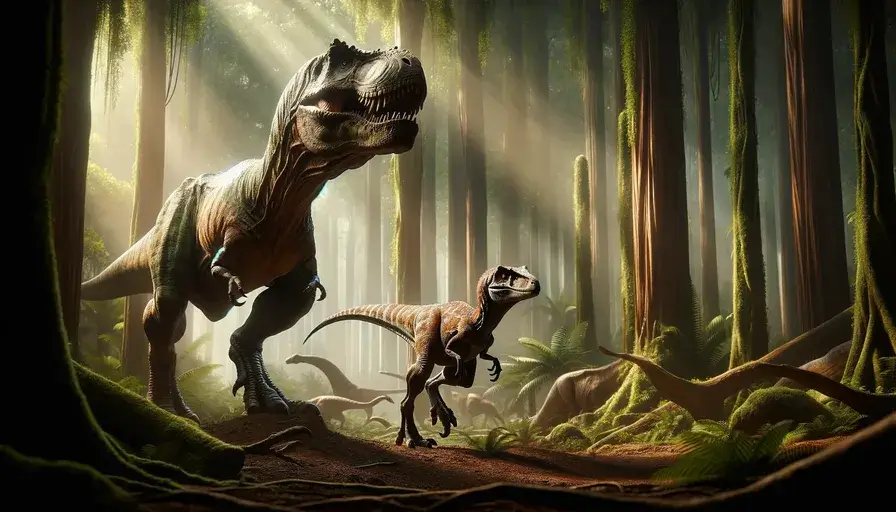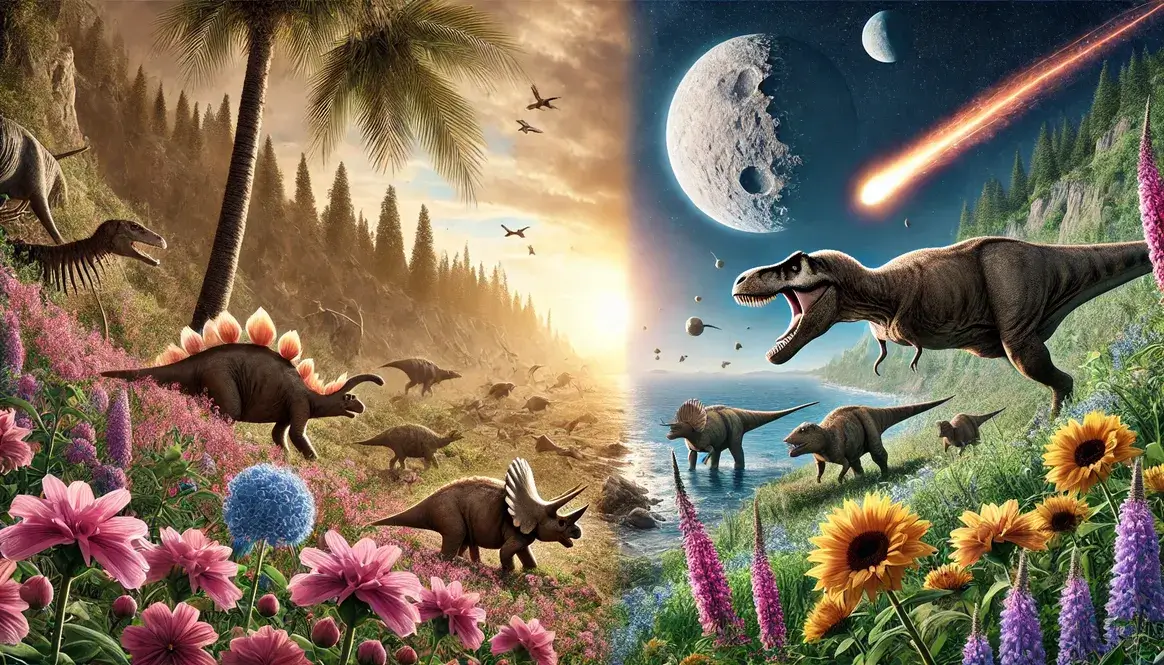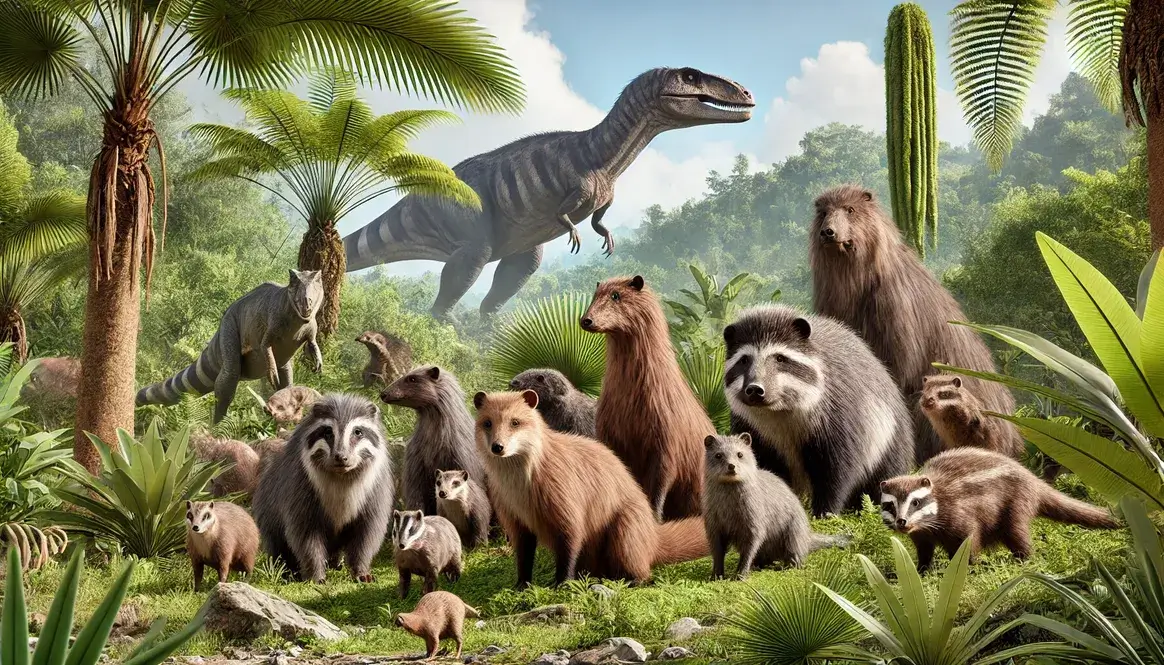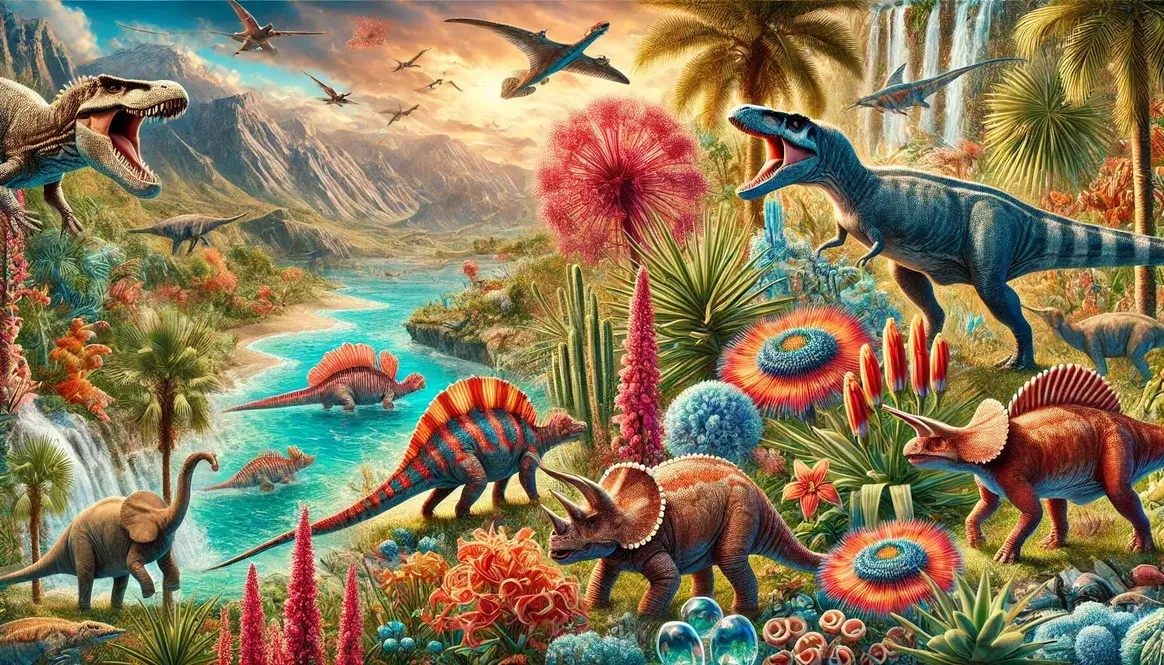Picture this: you’re walking through a dense forest during the Cretaceous period, around 145 to 66 million years ago. Suddenly, you hear a thunderous roar that shakes the ground beneath your feet. You freeze in your tracks, knowing that you’re in the presence of some of the most fearsome predators to ever walk the Earth – the tyrannosaurs and raptors.
These two groups of theropod dinosaurs ruled the Cretaceous period, leaving an indelible mark on both the ecosystems they inhabited and our collective imagination. From the towering T. rex to the swift and cunning Velociraptor, tyrannosaurs and raptors have captured our hearts and minds, starring in countless movies, books, and video games. But what were they really like? Let’s dive in and explore the fascinating world of these dominant theropods.
Tyrannosaurs: The Tyrant Lizard Kings

When you think of tyrannosaurs, the first image that probably comes to mind is the mighty Tyrannosaurus rex. But did you know that the tyrannosaur family was actually quite diverse, with over 20 known species? These impressive creatures ranged in size:
- The diminutive Dilong, which was about the size of a large dog
- The colossal T. rex, which could grow up to 40 feet long and weigh around 9 tons!
Tyrannosaurs were characterized by their:
- Large, powerful skulls
- Massive, serrated teeth (some species, like T. rex, had teeth that were up to 12 inches long – that’s about the size of a banana!)
These teeth were perfectly adapted for crushing bone and tearing flesh, allowing tyrannosaurs to hunt and feed on even the largest herbivorous dinosaurs of their time.
But tyrannosaurs weren’t always the giants we know and love. In fact, they started out as small, nimble predators during the Jurassic period. Over time, they evolved to become larger and more powerful, eventually dominating their ecosystems as apex predators. This evolutionary journey is a fascinating example of how animals can adapt and change over millions of years in response to their environment.
Speaking of apex predators, let’s talk about the impact tyrannosaurs had on their ecosystems. As the top predators of their time, they likely played a critical role in:
- Regulating the populations of other dinosaurs
- Maintaining the balance of their habitats
Some scientists even believe that tyrannosaurs may have hunted in packs, like modern-day wolves, which would have made them even more formidable hunters.
Fun Fact: The bite force of a T. rex was estimated to be around 12,800 pounds – that’s more than three times stronger than the bite of a great white shark!
Raptors: Swift and Deadly Hunters
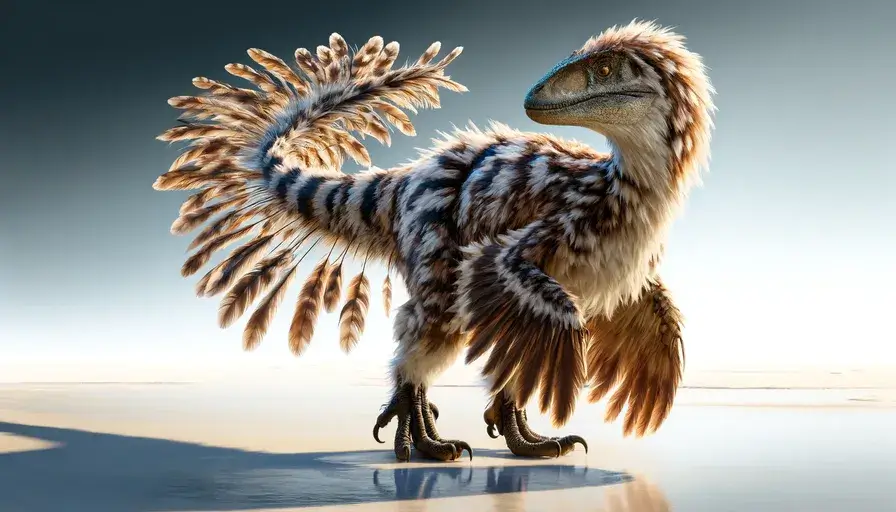
When most people hear the word “raptor,” they immediately think of the Velociraptor, thanks in large part to its starring role in the Jurassic Park movies. But just like with tyrannosaurs, there was a wide variety of raptors that lived during the Cretaceous period, each with its own unique characteristics and abilities.
Raptors were generally smaller than tyrannosaurs, ranging in size:
| Raptor Species | Size Comparison |
|---|---|
| Microraptor | Crow-sized |
| Velociraptor | Turkey-sized |
| Utahraptor | Wolf-sized |
They were characterized by their:
- Long, slender snouts
- Sharp claws
- Quick, agile movements
In fact, the name “raptor” comes from the Latin word “rapere,” which means “to seize or take by force” – a fitting name for these swift and deadly hunters.
One of the most distinctive features of raptors were their large, sickle-shaped claws on their second toes. These claws, which could grow up to 4 inches long in some species, were likely used to slash and disembowel prey, making raptors highly effective hunters.
But raptors weren’t just mindless killing machines – they were also highly intelligent and social animals, with some species even showing evidence of complex pack-hunting behaviors.
Another interesting aspect of raptors is their potential feathered appearance. While it’s still a topic of debate among paleontologists, there is evidence to suggest that many raptor species may have been covered in feathers, similar to modern-day birds. This would have provided them with insulation and may have even helped them to fly or glide short distances.
As small to medium-sized predators, raptors likely hunted a wide variety of prey:
- Insects
- Small mammals
- Other dinosaurs
They would have been quick and agile enough to chase down and take down prey much larger than themselves, using their sharp claws and teeth to deliver the killing blow.
Fun Fact: The Utahraptor, which was discovered in Utah in 1991, is the largest known raptor, measuring up to 23 feet long and weighing over 1,000 pounds!
In conclusion, tyrannosaurs and raptors were two of the most dominant and fascinating groups of theropod dinosaurs during the Cretaceous period. From their impressive size and strength to their quick intelligence and pack-hunting behaviors, these creatures continue to capture our imaginations and inspire new discoveries about the prehistoric world.
Here is the article with relevant internal links added:
Comparisons and Contrasts
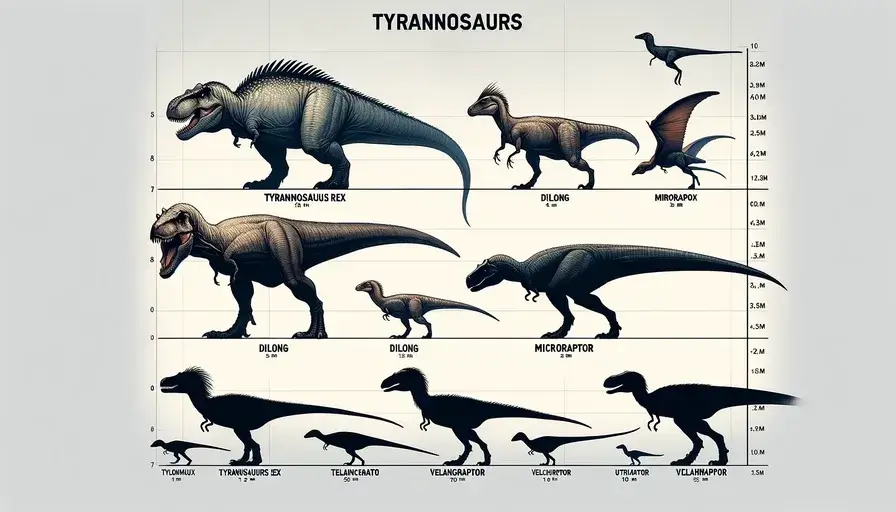
Now that we’ve explored tyrannosaurs and raptors separately, let’s take a closer look at how they compare and contrast.
| Characteristic | Tyrannosaurs | Raptors |
|---|---|---|
| Size | Large (up to 40 feet long) | Small to medium (up to 23 feet long) |
| Hunting Strategy | Powerful bite force, likely hunted large prey | Swift, agile movements, likely hunted smaller prey |
| Evolutionary History | Evolved from small, nimble predators to apex predators | Remained relatively small and agile throughout their evolutionary history |
| Impact on Environment | Regulated populations of other dinosaurs, maintained balance of ecosystems | Played important roles in their ecosystems as small to medium-sized predators |
While tyrannosaurs and raptors were both theropod dinosaurs, they had some notable differences:
- Size
- Hunting strategies
- Evolutionary histories
Tyrannosaurs were much larger and more powerful, with a hunting strategy that relied on their massive size and bite force. Raptors, on the other hand, were smaller and more agile, with a hunting strategy that relied on their speed and quick movements.
Despite these differences, tyrannosaurs and raptors also had some similarities:
- Both were bipedal (walked on two legs)
- Both had sharp teeth and claws used for hunting and defense
- Both were important predators in their ecosystems
It’s interesting to consider the potential interactions between tyrannosaurs and raptors. While they likely hunted different types of prey, there may have been instances where they:
- Competed for resources
- Preyed on each other
Some scientists have even suggested that smaller tyrannosaurs may have hunted in packs, similar to how some raptor species are thought to have hunted.
Pop Culture and Scientific Accuracy
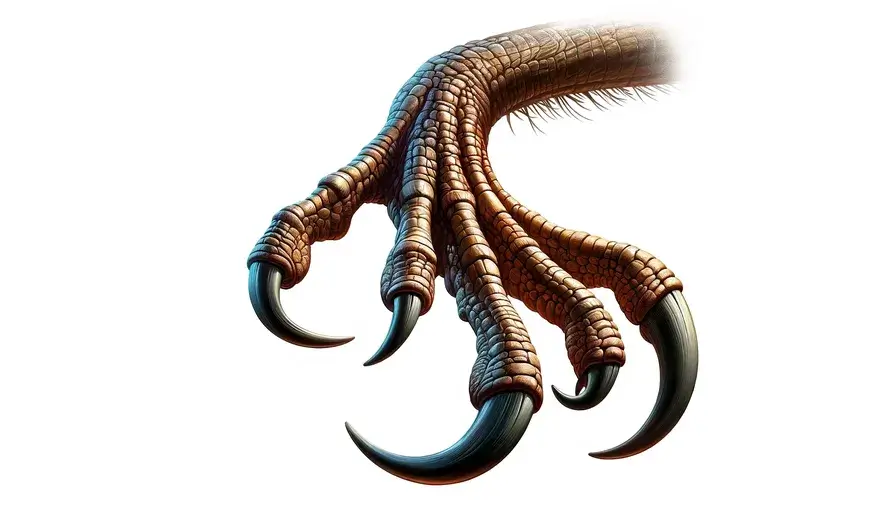
Tyrannosaurs and raptors have captured the public imagination like few other dinosaurs, thanks in large part to their portrayal in popular media. From the Jurassic Park franchise to The Land Before Time, these theropods have been depicted as everything from terrifying monsters to lovable sidekicks.
However, it’s important to recognize that these portrayals are not always scientifically accurate. For example:
- Jurassic Park movies depict Velociraptors as being much larger than they actually were
- Many depictions of T. rex show it with an upright posture and dragging tail, when in reality it likely held its body more horizontally and kept its tail off the ground
It’s crucial to distinguish between fact and fiction when it comes to dinosaurs in popular media. While movies and books can be a great way to get people interested in these fascinating creatures, it’s essential to seek out accurate scientific information to truly understand and appreciate them.
Fun Fact: Did you know that the sound effects used for the T. rex in Jurassic Park were actually a combination of tiger, alligator, and baby elephant sounds? The sound designers had to get creative to imagine what a real T. rex might have sounded like!
Conclusion
In conclusion, tyrannosaurs and raptors were two of the most dominant and fascinating groups of theropod dinosaurs during the Cretaceous period. Despite their differences in size and hunting strategies, both groups:
- Played important roles in their ecosystems
- Left a lasting impact on our understanding of dinosaur evolution and ecology
From their impressive adaptations to their portrayal in popular media, tyrannosaurs and raptors continue to capture our imaginations and inspire new discoveries about the prehistoric world.
As we continue to study these incredible creatures, we can gain a deeper appreciation for the:
- Diversity of life on Earth
- Complexity of past and present ecosystems
So if you’re fascinated by dinosaurs and want to learn more, there’s never been a better time to dive in. Whether you’re a paleontologist in the making or just a curious observer, the world of tyrannosaurs, raptors, and other theropods is waiting to be explored. Who knows what new discoveries and insights await us as we continue to unravel the mysteries of these ancient giants?

